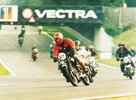In both theory and practice, the pairs of holes ought to be different sizes. The nearest pair to the pump should be smaller. If the two pairs of holes are the same size, more oil will flow through the first pair because there is less resistance to flow - it doesn't have so far to go. I know this to be true both by calculation and observation (drilling oil wells involves a lot of hydraulic calculation, and distributing oil evenly to the rocker bearings on a Rudge radial involves a lot of experiment). I have been told that this is often a cause of the remote big-end being the one to fail but have no personal experience of this. Nor do I know how one might calculate the difference, although experiment with an oil can might give an idea.
Apropos the 3 o-clock positioning, I can understand this on a plain bearing crank, because around TDC and BDC the shell is bearing hard on the crankpin, and no oil could escape. I think it matters far less on a roller big-end, because all that is necessary is that there IS oil in there. There's no need to maintain an oil film the way there is with a plain big-end.
(FWIW, I was amazed to discover that 60 bhp (rear wheel) Manx short-strokes with plain-bearing cranks use the standard Norton oil pump, which must generate the same immense pressure as a Vincent pump, ho, ho. The only difference(which can be seen below the bevel cover) is the fitting of a restrictor to reduce the oil fed to the cam box in favour of the crank.)
Apropos the 3 o-clock positioning, I can understand this on a plain bearing crank, because around TDC and BDC the shell is bearing hard on the crankpin, and no oil could escape. I think it matters far less on a roller big-end, because all that is necessary is that there IS oil in there. There's no need to maintain an oil film the way there is with a plain big-end.
(FWIW, I was amazed to discover that 60 bhp (rear wheel) Manx short-strokes with plain-bearing cranks use the standard Norton oil pump, which must generate the same immense pressure as a Vincent pump, ho, ho. The only difference(which can be seen below the bevel cover) is the fitting of a restrictor to reduce the oil fed to the cam box in favour of the crank.)
i have an alternative theory on this- with the oil appearing at 3 o'clock the work has already occured. a bit like bolting the stable door once the animal has escaped! i think,maybebetter, to have the oil appear before t.d.c, so that the oil is ready to help during the power stroke, at the time of maximum load. ford essex(3.0 litrev6) engines have the oil after t.d.c, they will not survive in a "hot "engine unless cross drilled to give oil as above. any one got some thing more? come on guys, this one is important.

